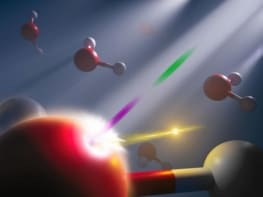
Frequency combs have been used by physicists in Germany and France to improve the performance of Raman spectroscopy – allowing the technique to identify several different molecules at the same time. The researchers say that it could be used to speed up the microscopic mapping of chemical species in a sample or be used to follow chemical reactions in real time. However, the new analytical method must be improved before it can be used routinely in the lab.
In coherent anti-stokes Raman spectroscopy, a sample is irradiated repeatedly by pairs of ultrashort laser pulses. The first pulse sets chemical bonds in the molecules vibrating, which causes the refractive index of the sample to vary periodically. This change in refractive index modulates the frequency of the second pulse. The gap between the two pulses is increased slightly with each subsequent pair, so the second pulse sees a slightly later point in the bonds’ vibration periods and its frequency is shifted by a slightly different amount. By looking at the sinusoidal variation in frequency shift with time lag, scientists can work out the vibration frequencies of the chemical bonds. As each type of molecule has a distinct signature of vibration frequencies, Raman spectroscopy can identify the presence of specific molecules in a sample.
Time consuming
The pair of pulses is usually generated from a single laser pulse that is split into two. One pulse is sent on a longer path, causing it to hit the sample slightly later. Changing the path length of that pulse varies the time lag. This works well if the aim of the measurement is to detect the presence of a known molecule. However, if there are several different target molecules – or if the goal is to identify unknown molecules – the entire measurement process must be repeated at multiple frequencies and this can be time consuming. The technique becomes more unwieldy if it is used to create a 2D image by scanning the light across a sample and acquiring Raman spectra at each pixel.
Now, researchers at the Max Planck Institute for Quantum Optics and Ludwig Maximilians University (LMU) and colleagues at University Paris-Sud have used frequency combs to get around this problem. Frequency combs produce an extremely rapid and stable series of femtosecond laser pulses, each containing a broad and highly regular spectrum of frequencies. Theodor Hänsch – the leader of the LMU and Max Planck groups – shared the 2005 Nobel Prize for Physics for inventing the frequency comb.
A thousand times faster
The team used two frequency combs, the second pulsing at a slightly slower rate than the first. As a result the combs moved in and out of phase, generating a series of pairs of pulses with a time gap that changes slowly. Because the technique does not involve the mechanical adjustment of a path length, it can acquire a single Raman spectrum about 1000 times faster than the traditional method. Furthermore, as each pulse contained a broad spectrum of frequencies, they could excite multiple bond vibrations simultaneously. Mathematical analysis of the complex relationship between the refractive index and the time lag between the pulses told the researchers what sinusoidal frequencies the pattern contained, and thus what chemical bonds – and therefore chemical species – had given rise to it.
There is a catch, however. The bond vibrations die out in picoseconds, so once the gap between the pulses has grown longer than this, the second pulse does not see any variation in refractive index at all until the time gap returns again to smaller values. “One of the limitations of our technique at the moment,” says team member Nathalie Picqué, “is that we can measure one full spectrum covering the entire fingerprint region [the electromagnetic region in which the bond vibrations occur] very quickly, but the time from one spectrum to the next is rather long.” The researchers plan to reduce this by using frequency combs that pulse more rapidly. Indeed, combs producing up to a billion pulses per second are available now and even faster combs are being developed.
Elegant combination
“Most of the elements here were done before,” says Yaron Silberberg of the Ultrafast Optics Group at the Weizmann Institute of Science in Israel. “People have used short pulses for Raman microscopy, and also people have used frequency combs for doing all kinds of tricks, but the combination is very elegant. They’ve combined two things and made you think, ‘Hey, how come nobody did this before?'”
Picqué hopes that the research will have applications beyond microscopy. “You could, for example, imagine that you would like to monitor a chemical reaction as a function of time. So you would want to measure the spectrum every ten microseconds in order to see how some product develops.”
The research is published in Nature.



